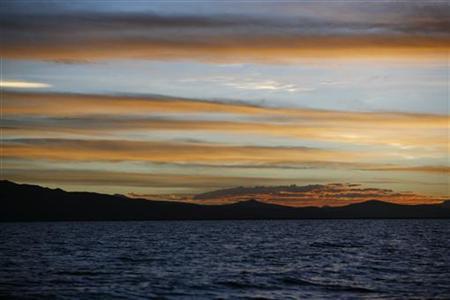Date: 01-Jul-09
Country: AUSTRALIA
Author: Michael Perry

Seagrass Losses Reveal Global Coastal Crisis Photo:
Mariana Bazo
Sunset is seen on Lake Titicaca.
Photo: Mariana Bazo
SYDNEY - Mounting loss of seagrass in the world's oceans, vital for the
survival of endangered marine life, commercial fisheries and the fight
against climate change, reveals a major crisis in coastal ecosystems, a
report says.
A global study of seagrass, which can absorb large amounts of planet-warming
carbon dioxide, found that 29 percent of the world's known seagrass had
disappeared since 1879 and the losses were accelerating.
Seagrasses are flowering plants found in shallow waters. They were vanishing
at the rate of about 110 sq km (42 sq miles) a year since 1980, said the
study to be published in the U.S. journal Proceedings of the National
Academy of Sciences.
The study by Australian and American scientists found seagrass meadows were
"among the most threatened ecosystems on earth" due to population growth,
development, climate change and ecological degradation.
It said there were only about 177,000 sq km left globally.
"Seagrass meadows are negatively affected by impacts accruing from the
billion or more people who live within 50 km (30 miles) of them," said the
report received by Reuters on Tuesday.
The study said the loss of seagrass was comparable to losses in coral reefs,
tropical rainforests and mangroves.
"Seagrasses are sentinels of change" and the loss of seagrass was an
indicator of a deteriorating global marine ecosystem. "Mounting seagrass
loss reveals a major global environmental crisis in coastal ecosystems," it
said.
ECONOMIC LOSSES
It is estimated that 70 percent of all marine life in the ocean is directly
dependent upon seagrass, according to U.S.-based Seagrass Recovery (www.seagrassrecovery.com).
Seagrasses are the only flowering plants that can live entirely in water.
They are most closely related to lilies and are very different to seaweeds,
which are algae.
Seagrass meadows provide important ecosystem services, said the study,
citing an estimated US$1.9 trillion a year in nutrient cycling, enhancement
of coral reef fish productivity, habitats for thousands of fish, bird and
invertebrate species and a major food source for endangered dugong and
turtles.
Seagrass beds are believed to rival rice paddies in their photosynthetic
productivity or the ability to extract greenhouse gas CO2 and convert it
into oxygen and stored carbon matter.
One acre of seagrass can lock away nearly 8 metric tonnes of carbon per
year, which equals the CO2 emissions from a car traveling more than 3,500
miles, says Seagrass Recovery.
The study said more than 51,000 sq km (19,700 sq miles) of grass had been
lost in the past 127 years, with largest losses (35 percent) occurring after
1980.
"Seagrass losses decrease primary production, carbon sequestration and
nutrient cycling in the coastal zone. If the current rate of seagrass loss
is sustained or continues to accelerate, the ecological losses will also
increase, causing even greater ill-afforded economic losses," said the
study.
© Thomson Reuters 2009 All rights reserved
